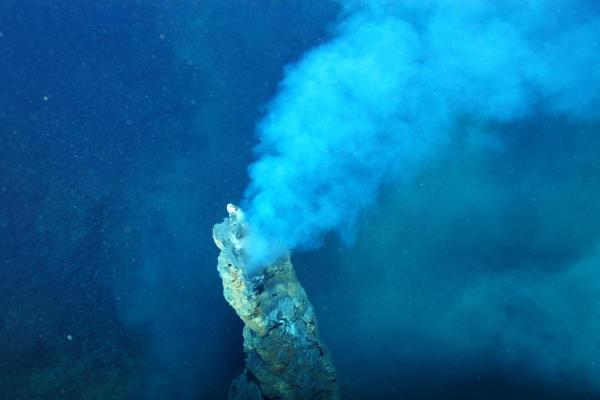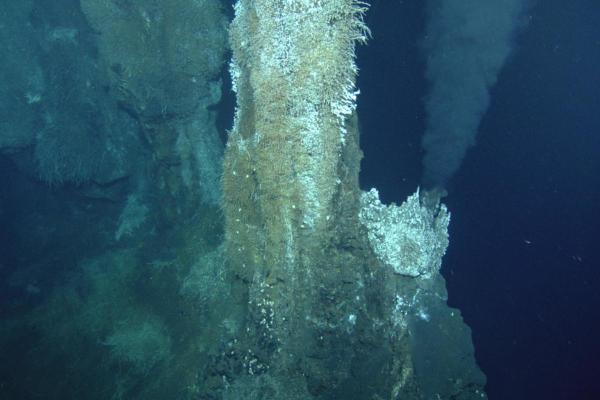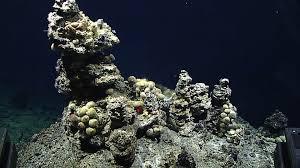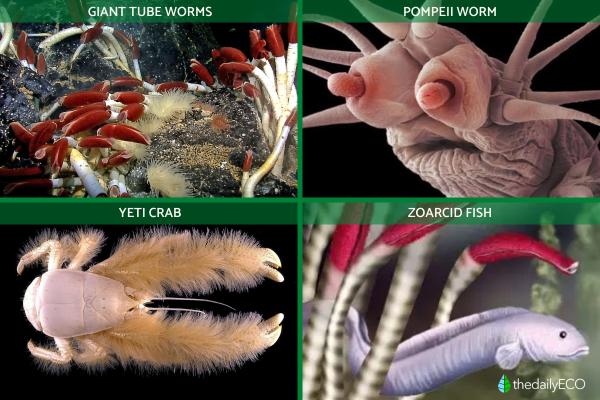
The 1977 discovery of hydrothermal vents revolutionized our understanding of life. Found 2,000 to 4,000 meters (6,500 to 13,000 feet) below the ocean's surface, these geothermal formations create unique ecosystems through chemosynthesis rather than photosynthesis. From towering black smoker chimneys reaching scorching temperatures of 400°C (752°F) to the uniquely adapted organisms that survive there, hydrothermal vents showcase the incredible power of life to adapt.
The following article by thedailyECO explores what hydrothermal vents are, their formation, types, and the extraordinary life they sustain.
What are hydrothermal vents?
Hydrothermal vents are fissures in the ocean floor that release super-heated water. These formations occur where magma lies close to the Earth's crust, heating seawater that seeps through cracks. As this water travels deeper, it reaches temperatures up to 400°C (750°F), dissolves minerals and metals from rocks, then erupts back into the cold ocean.
The vents primarily form along mid-ocean ridges, which are underwater mountain chains that stretch 46,000 kilometers where tectonic plates pull apart. While they appear throughout the oceans, the Pacific Ring of Fire contains a high concentration, especially along the East Pacific Rise and Mid-Atlantic Ridge. These geological features typically sit 2,000 to 4,000 meters below the surface under intense pressure.
Among these formations, "black smokers" represent the most common type of vent. The hydrothermal fluid flowing from these fissures gradually builds tall chimney-like structures. Their characteristic black color stems from high concentrations of metals, sulfides, and acids extracted from the surrounding rocks, which precipitate when the hot fluid meets cold ocean water.
Despite the harsh conditions like extreme heat, high pressure, and low oxygen, these vents support complex ecosystems. Since sunlight cannot reach these depths, the food chain begins with specialized bacteria that convert minerals from the vent fluid into energy through chemosynthesis.
These bacteria sustain communities of adapted animals, including giant tube worms, blind shrimp, and deep-sea crabs. The extreme environment has led to the evolution of species found nowhere else on Earth, each developed to withstand these intense conditions.
While hydrothermal vent creatures rely on chemical energy, most life on Earth depends on tiny oxygen-producing organisms. Learn about these ancient microbes in our article on what cyanobacteria are.

Did life originate from hydrothermal vents?
The 1977 discovery of thriving communities around these vents changed our understanding of where life can exist. The organisms here survive without sunlight at high temperatures, high pressure, and in highly acidic conditions, an environment previously thought too extreme for life. Instead of relying on sunlight, these organisms use chemical energy from the vent fluids to sustain themselves.
Many scientists now propose that similar conditions may have supported Earth's first life forms. The vents provide several key ingredients needed for life: a constant energy source, concentrated chemicals, and protection from harmful surface conditions. The hot, mineral-rich fluids could have triggered chemical reactions that formed complex organic molecules, which are the building blocks of life.
This connection between hydrothermal vents and life's origins has implications beyond Earth. Since these ecosystems show that life can thrive in sunless, extreme environments, scientists are exploring similar environments on other worlds. Ocean-bearing moons like Europa and Enceladus, which may have hydrothermal activity, have become prime targets in the search for extraterrestrial life.
Fascinated by ancient life on Earth? Dive deeper into Earth's earliest traces of life in our article about the oldest fossil ever found.
How are hydrothermal vents formed?
Hydrothermal vents form through a series of geological processes that begin with seafloor spreading at tectonic plate boundaries.
When oceanic plates move apart, they create cracks in the Earth's crust that allow seawater to penetrate deep below the surface. This process connects directly to the continuous cycle of oceanic crust formation and destruction.
- The formation process starts when cold seawater (around 2°C) seeps through fissures in the ocean floor. As this water moves deeper into the crust, it enters regions where magma chambers heat the surrounding rock.
- The proximity to magma dramatically heats the trapped seawater, which can reach temperatures exceeding 400°C. At these temperatures, the water exists in a superheated state due to the immense pressure at ocean depths.
- This superheated water becomes chemically transformed through interactions with the surrounding rocks. The heat and pressure cause the water to dissolve minerals and metals from the basaltic rocks, creating an acidic solution enriched with dissolved compounds. The hot, mineral-laden water then rises back toward the surface through additional fissures, following the principle that hot fluids are less dense than cold ones.
- The rapid cooling process that occurs when the superheated water meets cold ocean water triggers a series of chemical reactions. Dissolved minerals precipitate out of solution, forming solid deposits that accumulate around the vent opening. Over time, these deposits build up to create the characteristic chimney structures.
The mineral composition of these chimneys varies depending on the underlying rock chemistry and water temperature, but they typically contain iron, copper, zinc, and sulfur compounds.
The entire system operates as a natural heat engine, driven by geothermal energy from the Earth's interior. This energy transfer system not only shapes the physical structure of the ocean floor but also provides the energy source for specialized ecosystems.

Types of hydrothermal vents
Hydrothermal vents come in a few different forms, but black smokers and white smokers are the most common. What makes each type unique is the temperature of the fluid they release, along with the minerals and chemicals it contains. Let's take a closer look at each one:
Black smokers
These vents emit the hottest fluids, reaching temperatures between 350°C and 400°C (662°F to 752°F). The dark color of their plumes comes from iron sulfide, copper, and other mineral deposits that precipitate when the super-heated water meets cold ocean water.
The chimneys of black smokers grow rapidly, sometimes several feet per day, and can reach heights of 45 meters (148 feet). The mineral-rich fluid appears black because of the high concentration of sulfide minerals, particularly iron sulfide.
Black smokers typically form larger, more stable structures due to their higher mineral content and temperature. Their chimneys consist of multiple layers, an inner wall of copper-iron sulfides and an outer wall of iron sulfides mixed with other minerals.
The different chemical and temperature conditions around black and white smokers support varied biological communities. Black smokers typically host heat-tolerant organisms adapted to higher concentrations of sulfides and metals.
White smokers
White smokers release cooler fluids, typically between 100°C and 300°C. Their lighter color results from different mineral content, primarily barium, calcium, and silicon compounds.
These vents often form away from the main hydrothermal fields. The white color appears when minerals like silica, anhydrite, and barite precipitate from the cooler fluids. White smoker chimneys grow more slowly than black smokers and tend to be smaller.
White smokers form more delicate structures with thinner walls composed mainly of silica and sulfates.
Unlike black smokers, white smokers often support diverse communities due to their moderate temperatures and less extreme chemical conditions.
Curious about other volcanic features beneath the waves? Explore our article about submarine volcanoes and their impact on ocean ecosystems.
What animals live in hydrothermal vents?
Deep-sea creatures at hydrothermal vents have evolved specialized adaptations to survive in extreme conditions. Here are the main animal groups and their adaptations:
Giant tube worms (Riftia pachyptila)
These worms grow up to 2 meters (6.6 feet) long and lack a digestive system. Instead, they host symbiotic bacteria in their tissue that convert chemicals from vent fluid into food. A red plume at the top of each tube absorbs oxygen and carbon dioxide, while their white tubes protect them from the hot water.
Pompeii worms (Alvinella pompejana)
These worms can withstand temperatures up to 80°C, making them among the most heat-tolerant animals on Earth. They build paper-like tubes on vent chimneys and maintain a symbiotic relationship with bacteria that form a protective fleece on their backs.
Yeti crabs (Kiwa hirsuta)
These white, hairy crabs farm bacteria on their arms. They wave their bacteria-covered limbs over hot vent fluids, allowing the microbes to feed on chemicals in the water. The crabs then eat these bacteria.
Deep-sea mussels
Unlike shallow-water mussels, these have modified gills that house chemosynthetic bacteria. The bacteria provide food for the mussels, which can grow to large sizes despite the lack of photosynthetic food sources.
Blind white shrimp (Rimicaris exoculata)
These shrimp cluster in dense swarms around vent openings. Though blind, they have a light-sensing organ on their backs that helps them stay in the vent's warm water zone. They also farm bacteria on their bodies for food.
Scale Worms
These armored worms crawl across chimney walls, grazing on bacterial mats. Their scales provide protection from the hot vent water.
Zoarcid Fish
These fish adapt to the high pressure and toxic conditions through specialized blood proteins and enzymes. They prey on smaller vent animals and can withstand the warm water near vents.
Did you know there's a snail that uses iron from vent fluids to build a metallic shell? Discover this amazing creature in our article on the volcano snail.

If you want to read similar articles to What Are Hydrothermal Vents?, we recommend you visit our Wild animals category.
- Alor JP and Caballero JAG. (2004) . Hydrothermal systems and the origin of life . Science 75: 14-22
- Paz NS. (2012). Thermal environments: evidence of biological activity in fossil thermal systems (epithermal veins) and current ones in the Incachule lagoon, Puna Salteña . Revista Temas BGNOA 2(2): 54-63.
- Covacevich TS. (sf). Antarctica and its hydrothermal vents. Chilean Antarctic Institute.